Panasonic Lumix DMC-GF2 Review
Panasonic Lumix DMC-GF2 Introduction
The Panasonic Lumix DMC-GF2 is a compact Micro Four-Thirds SLD from Panasonic. It is designed to provide the versatility of ILCs and high image-quality in a small size. A 12 megapixels LiveMOS sensor capable of ISO 100 to 6400 and full 1080p HD video is at its center.
The Panasonic GF2, unlike its predecessor, is targeted at novice photographers. It has a simplified interface that favors automatic features over photographic controls. Even so, it provides advanced features to be occasionally creative and let beginners to learn more before they upgrade to a higher-end camera.
Its lens mount makes the GF2 compatible with a growing number of Micro Four-Thirds lenses which are often designed for compactness. A number of those from Panasonic feature Optical Image Stabilization which is useful to compensate for camera shake on SLDs like this one which do not have built-in stabilization. Further system expansion is possible using the hot-shoe and proprietary accessory port.
This digital camera review analyses the features, usability, image quality and performance of the Panasonic Lumix DMC-GF2.
Panasonic Lumix DMC-GF2 Features
Sensor
- 12 Megapixels CMOS Four-Thirds sensor
- Micro Four-Thirds lens mount
- Built-in ultra-sonic dust-reduction
Exposure
- ISO 100 to 6400 sensitivity
- Intelligent & Standard Auto ISO, customizable limit from 200 to 1600
- 1/4000 to 60s Shutter-speeds
- PASM Exposure modes with Program-Shift
- Multi-Segment, Center-Weighed and Spot metering
- Exposure-Compensation, ±3, 1/3 increments
- Auto-Exposure Bracketing, 3 or 5 frames, 1/3 or 2/3 EV increments
- Auto, Auto Redye, Forced, Forced Redeye, Slow-Sync, Slow-Sync Redeye, Off flash modes
Image Parameters
- Automatic, 5 presetsSunny, Cloudy, Shade, Tungsten, Flash, Kelvin and 2 custom white-balance settings
- White-balance fine-tuning along 2 axis in 19 steps
- WB Bracketing, 3 frames, 2 step sizes along 2 axis
- Adjustable contrast, sharpness, saturation and noise-reduction, 5 steps each
- Color and B&W mode
- sRGB or Adobe RGB color space
Drive
- Continuous drive, 5 FPS without preview or 3 & 2 FPS with preview, Unlimited JPEG or 7 RAW
- Self-timer, 2s, 10s or 3 shots @ 10 seconds
Focus
- Single-shot autofocus (AF-S), continuous autofocus (AF-C) or manual-focus (MF)
- Center-point, 23-points, subject tracking and face-detect contrast-detect autofocus
- Optional quick-shift autofocus
- Optional MF magnification
- Optional AF-Assist lamp
Video
- AVCHD codec: 1080i & 720p, 2 quality levels
- M-JPEG codec: 720p, WVGA, VGA, QVGA
- Built-in stereo microphone
- Audio-level meters, 2 channels
- Audio-input gain, 4 steps
- Wind-filter, 3 levels or off
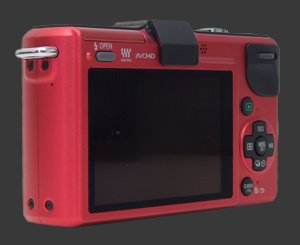
Display & Viewfinder
- 3" LCD, 460K Pixels
- Optional live histogram
- Optional guidelines, 3 types
- Optional blinking highlight
- Adjustable brightness, 7 steps
- Adjustable saturation, 7 steps
- Adjustable color, 11 steps, 2 axis
- Optional EVF via accessory port, sold separately
Output Processing
- 4:3 Native aspect ratio
- 3:2, 16:9 & 1:1 cropped aspect ratios
- 12, 6 and 3 Megapixels mode
- JPEG, RAW, RAW+JPEG capture
- 2 JPEG Compression qualities
- Optional contrast enhancement, 3 levels
- Optional resolution enhancement, 4 levels
- Optional face-recognition
Connectivity
- Hot-shoe for external lighting
- HDMI (1080i) output
- A/V (NYSC / PAL) output
- USB 2.0 connectivity
Misc
- One clickable control-dial
- Customizable Q.Menu button
- Lithium-Ion battery
- SDXC memory
- Lens stabilization control, 3 modesPreview and exposure, Exposure only, Panning
Panasonic Lumix DMC-GF2 Usability - How easy is it to use?
The Panasonic Lumix DMC-GF2 has boxy shape with a small bulge serving as a hand grip. This is not much of an issue since ILCs are usually supported with the other hand under the lens barrel. The real problem is that it a tight grip is required which quickly gets uncomfortable. Equally discomforting is the neck-strap eyelet which digs at the base of your finger as it reaches towards the shutter-release. Given that the camera always needs a protruding lens, there is no reason for such a small grip other than being able to claim the camera is smaller.
The top plate of the GF2 is entirely used with, from left to right: the built-in flash, the hot-shoe, the power button, a stereo microphone, the shutter-release, an Intelligent Auto button and the Video Record button. The important shutter-release is a standard two-stage one with a soft halfway point.

The Video Record button is flush with the surface of the camera. It starts recording video after a small delay and stops it such as the last second or so gets chopped. The exact delay depends on the video mode but is roughly 1s for 1080i. There is no video mode to let the camera prepare itself for filming. This also makes it impossible to setup framing for video since the framing for stills is shown on the LCD until recording starts.
The Intelligent Auto button is there to toggle fully automatic mode without entering the menu system. There is an option to avoid potential accidents by requiring that button to be held for one second before it takes effect. Intelligent Auto mode uses automatic scene recognition and disables most settings except for EC and Drive-Mode.
The hot-shoe is there to support an external flashes and a number of accessories using the proprietary port. The most important accessory is an optional EVF to enable eye-level photography which gives better stability and improves framing ease. To the left is the built-in flash. When it raised, it advances forwards yet not enough to clear the 14-42mm F/3.5-5.6 kit lens.
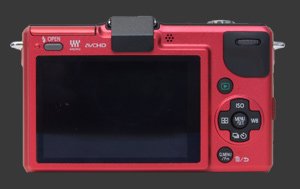
The back of the GF2 is mostly occupied by a 3" touchscreen LCD with 460K pixels. While a number of buttons to the right of the LCD can control this digital camera, the touchscreen gives access to a number of functions not otherwise accessible. A few of those functions can be disabled but the touchscreen always remains active. Not only does this force the user to smudge the display but odd things happen when one tried to wipe those smudges off!
Visibility of the display itself is generally good and the anti-reflective coating is moderately effective. The viewing angle is also quite good. The display refreshes quickly and follows motion well. The camera is not Exposure-Priority. There is a optional misleading live-histogram based on the brightness of the display rather than that of the metered exposure.
 The remaining controls of the GF2 are found to the right of the LCD. At the top is a clickable control-dial. Pressing it toggles its behavior depending on the exposure mode:
The remaining controls of the GF2 are found to the right of the LCD. At the top is a clickable control-dial. Pressing it toggles its behavior depending on the exposure mode:
- P: Program-Shift, EC
- A: Aperture, EC
- S: Shutter-Speed, EC
- M: Aperture, Shutter-Speed
- iA: Nothing, EC
- My Color: Nothing
- Scene: Nothing, EC
The Playback button toggles Playback mode. Since the Lumix GF2 is Shooting-Priority, tapping the shutter instantly exits Playback mode. There is a Q.Menu/Fn button at the lower edge of the camera. This one either brings up the menu system or performs a configurable action. Since this digital camera does not have an AE-L button, the customizable can setup to do lock exposure.
A 4-way controller with central Menu button is the only remaining physical control. Each direction of the controller is assigned a function:
- Up: Selects the ISO between 100 and 6400 or one of two automatic settings. The standard Auto ISO setting use ambient light levels to set the ISO, while the Intelligent Auto ISO setting measures subject movement to set it.
- Right: Selects White-Balance. The screen which appears when Right is pressed is also used to fine-tune white-balance or enable WB bracketing.
- Down: Controls the drive mode. Options are: Single-Shot, Continuous (High-Speed without preview, Medium Speed or Low speed), Bracketing and Self-Timer (2s, 10s or 3-frames at 10s).
- Left: Selects the AF mode. Options are: Single-Point, Automatic 23-Area, Tracking and Face-Detection. The screen which appears is also used to set the focus point or area, depending on the mode.
The GF2 seems well constructed and has a confidence-inspiring weight without ever feeling heavy. The battery and memory card compartment door is reasonably sturdy too. The only flimsy part is the small flap covering the I/O ports on the side of the camera. At the bottom of the camera there is a metal tripod mount directly inline with the optical center of the camera. This is the ideal placement to make panorama photos.

Using the Panasonic Lumix GF2 for casual photography is fine. Having a light capable camera along is quite liberating compared to most compact cameras. One can shoot in relatively low-light and still manage to focus and get good results. For extended use, the lack of a proper grip gets tiresome as does the lack of a viewfinder. Luckily, Panasonic sells an EVF to solve the latter problem. With it, the photographer get less tired from holding the camera away from his body and provides more stability while shooting.
Panasonic SLDs get stabilization from lenses. Since only specific lenses offer stabilization, options for low-light hand-help photography are limited. The GF2 controls which of 3 stabilization mode gets used which is shown on the display. It is misleading though that the stabilization mode icon appears there even when the attached lens does not offer stabilization.
Panasonic Lumix DMC-GF2 Performance - How well does it take pictures?
Performance starts with image quality, which is the criteria used as the foundation of our digital camera ratings. Ergonomic issues may get in the way, but in the end, image quality counts the most. For an ILC, image quality greatly depends on the lens used. While color, noise, exposure and dynamic-range are properties of a camera, distortion, vignetting and chromatic aberrations are properties of the lens. Sharpness and contrast depend on the weakest link. That is, a camera cannot capture more details than a lens lets through. Conversely, it is quite possible for a lens to transmit more details than a sensor can capture.
Image Noise & Details
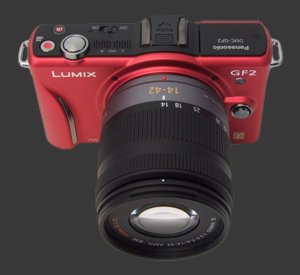
The Panasonic Lumix DMC-GF2 shows good image quality with relatively low image noise up to ISO 400. Noise becomes noticeable at ISO 800 and is slight more pronounced at 1600 but both settings are quite usable. At ISO 3200, noise becomes more destructive and fine details start disappearing. The maximum sensitivity of ISO 6400 is clearly noise while remaining usable for small prints and sharing online.
Those who have been keeping track will notice that the GF2 turns in a performance comparable to the previous generation of large CMOS sensors. Such performance was described as high image quality originally and it still is. The only thing is that the latest cameras can do even better at the higher sensitivies.
Noise-reduction is adjustable from -2 to +2, where the default setting of 0 is destroys details at all sensitivities. Better results are obtained with a setting of -2 with little difference in image-noise at low sensitivities. From ISO 800 onwards, higher NR hides noise but does even more damage to image details. It appears that the amount of NR varies according to light levels in addition to sensitivity.
Color & White Balance
Color accuracy is quite good. This camera ommits the Film modes of its predecessor, instead just offering Saturation and Contrast settings to control color and tonality. Defaults give the most natural look. Each of these settings, plus Sharpness, can be adjusted in 5 fine steps. Since differences between each steps are minimal, the GF2 never produces results that are far from reality.
Automatic While-Balance performance is excellent. It compensates well of a variety of lighting, even indoors which most cameras struggle with. This is a great improvement of the GF1. To perfectly controlo color-balance, the Custom White-Balance option is spot on. One very welcome feature of the Panasonic Lumix GF2 is that the LCD can be adjusted in terms of Saturation and Tint along 2 axis. This makes it possible to calibrate the display so that it correctly previews white-balance. What this effectively does is allow white-balance fine-tuning to to be set reliably.
Exposure
The Panasonic GF2 has an excellent multi-segment metering system. It is generally conservative and with only occasional over-exposure in the presense of small highlights. For low-contrast scenes, it needs a little positive compensation but less than most cameras
It is important to remember that the LCD is not Exposure-Priority so it only previews exposure for scenes which fall well within the metering range while the camera is in an automatic or semi-automatic mode. One may note the live-histogram to be off by about 1/3 EV, so the preview is more reliable.
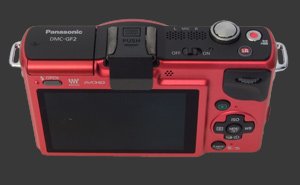
Auto Focus
The GF2 has a fast contrast-detect autofocus system. It locks focus quickly and accurately under most circumstances. Even under moderate light it takes about ½s to lock focus. It takes just a little longer in low-light, reaching up to 1s in extreme conditions. This is certainly a very good performance compared to anything but a modern DSLR.
To speed things up, Panasonic provides an option called Quick-AF. In this mode, the GF2 starts focusing as soon as the camera is held steadily, presumably because the photographer is getting ready to take a shot.When the shutter-release is pressed halfway, the GF2 then only needs to adjust focus a little.
Speed
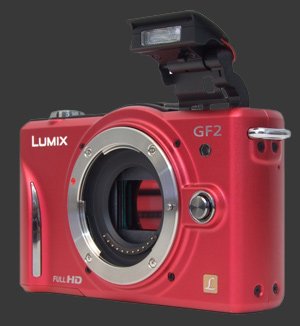
The GF2 generally remains quite responsive. Most buttons and dials get an instant response. Compared to other SLDs, it performs about average, meaning faster than most fixed-lens cameras but slower than most DSLRs. The following rough measurements characterize its performance:
- Power-On: 1 second
- Power-On to First-Shot: 2 seconds
- Autofocus: ½s on average. Dependent on subject, light and lens
- Shutter-lag: Nearly instant with about ½s blackout
- Shot-to-shot: About 3/4s for fast shutter-speeds
- Playback: ¼s to enter, ½s to exit
- Power-Off: 2 seconds
- Video: ½s to 1s to start, -1s to stop
For non-action shots, these numbers are very reasonable and the GF2 rarely gets in the way of getting a shot. The odd measurement here is that the GF2 cuts off about 1 second from the end of videos. The Panasonic GF2 is powered by a proprietary Lithium-Ion battery which provides 300-shots per charge with 50% flash use. This is below average among SLDs yet should be enough for a day of shooting, particularly since the built-in flash is of limited use.
Panasonic Lumix DMC-GF2 Conclusion
The Panasonic Lumix DMC-GF2 provides a great compromise between image quality and size. Image quality is superior to similarly priced high-end compacts without being much larger, so people who want to capture high-quality images of their lives without much hassle will really enjoy the GF2 and its simple interface.
This compact SLD turns in a very well balanced performance, with low image noise, good color, excellent white-balance, great metering and relatively fast speed. There is really no area where the Lumix GF2 has issues with photography. Despite the absence of a dedicated mode which causes some frustrations, the GF2 captures full HD videos in high-quality.
Overall, Panasonic managed to produce a capable camera at a compelling price-point aimed directly at novices looking for improved image quality without acquiring something too bulky. For more serious users, Panasonic also offers the more advanced and efficient GH2 reviewed here. The main reason not to consider SLD cameras such as these ones would be for action photography where DSLRs still outperform.
 |
Please Support Neocamera
All information on Neocamera is provided free of charge yet running this website is a huge endeavor. Purchases made via affiliate links found throughout the site help keep it running and up-to-date. There is no additional cost to you, so please consider buying via these links to our affilates:
If you found any information on this site valuable and did not purchase via our affiliate links, please considering donating via PayPal:
Any amount will be greatly appreaciated. Thank you for your support!
Panasonic DMC-GF2 Highlights
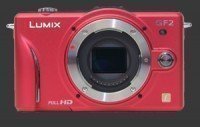
Sensor-Size: 17 x 13mm

Actual size when viewed at 100 DPI
| 12 Megapixels Mirrorless | ISO 100-6400 |
| Micro Four-Thirds Mount 2X FLM | Shutter 1/4000-60s |
| 0.20" Optional EVF 200K Pixels (0.52X) | Full manual controls, including Manual Focus |
| Built-in Dust Reduction | Custom white-balance with 2 axis fine-tuning |
| 3.2 FPS Drive, Unlimited Images | Spot-Metering |
| 1920x1080 @ 30 FPS Video Recording | Hot-Shoe |
| 3" LCD 460K Pixels | Lithium-Ion Battery |
| Secure Digital Extended Capacity |
Updates
2025.01.18

Fujifilm GFX 2025 Lens Roundup
Lens Review roundup of Fujifilm GFX Medium-Format lenses. Quality, performance and handling of the GF20-35mm F/4R WR, GF30mm F/3.5 Tilt-Shift and the GF55mm F/1.7.
2024.11.18

Best 2024 Photography Gifts for Every Budget
Great gifts for photographers and photo enthusiasts selected for every budget among the best products of 2024.
2024.08.07

Eye Protection Tips for Professional Photographers
The four main considerations for professional photographers regarding eyewear.
2024.07.14

Fujifilm X100VI Review
Flagship fixed-lens compact digital camera with a 40 MP sensor and Image-Stabilization, a first for the series. Retro design featuring dual control-dials, plus direct ISO, Shutter-Speed and EC dials. Its hybrid viewfinder can switch between EVF and OVF mode.
2024.05.09

Fujifilm GFX100 II Review
Flagship 102 Megapixels Medium-Format Mirrorless Digital Camera with 8-Stop 5-Axis IBIS, 8 FPS Drive, 8K Video and 400 MP Super-Resolution capture in a weatherproof and freezeproof body with dual control-dials and dual memory-card slots.
2024.04.03

Fujifilm X-T5 Review
Newest Fujifilm flagship boasting a 40 MP APS-C sensor, 5-axis IBIS with 7-stop efficiency, 15 FPS continuous drive, 6.2K Video capture, dual control-dials and dual SDXC UHS-II slots in a sturdy weatherproof and freezeproof body.
2023.11.20

Best Digital Cameras of 2023
Find out which are the Best Digital Cameras of 2023. All the new Mirrorless Digital Cameras from entry-level to high-end professional.
2023.07.10

Fujifilm X-H2 Review
40 Megapixels APS-C Hybrid Mirrorless Digital Camera with 7-stop IBIS. Fastest shutter ever and 8K video capture. Large builtin EVF with 0.8X magnification and 5.8 MP, plus an Eye-Start Sensor. Packed with features and large number of controls in a weatherproof and freezeproof body.
2023.05.07

Sony FE 20-70mm F/4G Review
Review of the unique Sony FE 20-70mm F/4G lens. The optical zoom of this lens spans ultra-wide-angle and medium focal-length coverage, making it one of the most versatile Full-Frame lenses on the market.
2023.01.15

Huion Inspiroy Dial 2 Review
Review of the Huion Inspiroy Dial 2 tablet, a medium sized drawing surface with dual dials and customizable buttons. Connects via USB-C or Bluetooth 5.0 with Windows, Linux and Android support.
2022.12.08

How to Pack for a Photo Trip
Find out how to pack for a travel photography trip, carry your gear safely while meeting airline regulations.
2022.11.13

Best Digital Cameras of 2022
The best digital cameras of 2022. A short list of the most outstanding models in their respective categories. Choose one for yourself or as a gift.













